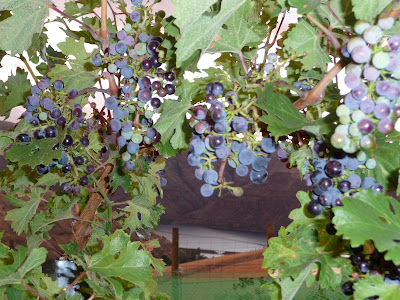 |
| The Therrien Family, back row: Guy, Tanner, A.J. & Josh, front row: Jeanne & Jillian |
My name is Guy Therrien. My wife, Jeanne and I have three boys. Josh is an athletic trainer for Oregon State University. He is married to Jillian. Our second son, A.J. is a senior at Washington State University, studying Construction Management. Our youngest son, Tanner, is a junior at Pullman High School, and a recent state champion in basketball.
We live and work in the Pullman, Washington area. I married into my wife's family's farming business 23 years ago. I work with her and her father, Allan Hood.
 |
| The vineyard along the Snake River |
When we aren't working, we enjoy fishing, hunting, hiking, watching our kids play sports, and watching WSU (Washington State University) Cougars sports.
We have a hobby vineyard in the Snake River Canyons. Our vineyard has eight - 200' rows. Four of the rows are Cabernet Sauvignon and four rows are Shiraz grapes. The vines are about 9 years old. We trade the grapes for wine from Wawawai Canyon Winery. It's a pretty good deal!
 |
| Cabernet grapes |
Since I started 23 years ago, so much has changed. The obvious changes are in the machinery we use. It's larger, faster, and so much more technologically advanced now. Our tractors have navigation, speed control, auto steering, four wheel drive, etc. This adds a little more to the production costs.
Less obvious changes have happened in our farming practices. We no longer plow or disk the soil. We have put grass strips in highly erodible places, and we till the ground very few times. These practices have virtually eliminated erosion.
 |
| Oops! |
I feel that our biggest challenges are the same as they have always been. We have to sell our crops for more than we have invested in them. We receive a higher price for our crops these days than 10 or 20 years ago, but our costs have increased also.
The most satisfying rewards happen at the end of harvest. All the difficult decisions, spending, sweating and sleepless nights have produced a finished product that helps feed the world, and hopefully, we have earned a little profit.
 |
| Lucky the Llama |
No comments:
Post a Comment